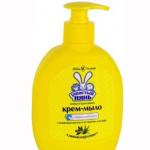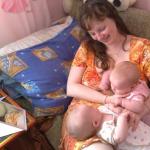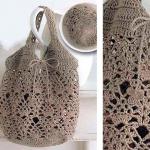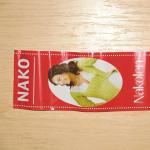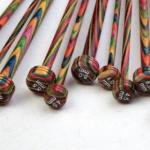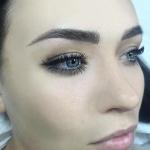Targeted walks lesson plan (middle group) on the topic. Summary of the target walk “What has summer brought us? Summary of target walk in March middle group
Educational areas: « Cognitive development», « Speech development».
Chapter: Getting to know nature.
Program content:
— Continue to reinforce in children the idea of the plant world, that all plants grow on the ground.
- Encourage children to imagine the seasons, vegetables and fruits;
— To instill in children a desire to take care of garden plants, teach them to recognize the need for watering (dry soil), and distinguish between dry and wet soil.
— Introduce the phrase “earth is a nurse”, “earth is mother” into the children’s active dictionary.
Equipment: a bear cub (toy), a diagram of an ecological trail, a box of fruits and vegetables, baskets (yellow and brown).
Walking progress:
Educator:- Children, meet this little bear, his name is Toptyzhka. He came to visit us and wants to take a walk with us. Oh, wait, why are you Toptyzhka, in a hat and a warm scarf? You cold?
Teddy Bear(to the teacher): - No, but I know that when you go outside, you need to dress warmly. So as not to catch a cold!
Educator:- Bear, you got everything mixed up. And now our guys will explain everything to you.
- Children, tell Toptyzhka what time of year it is?
- What happens in the summer?
— How do people dress in summer?
— What grows in the flower beds and gardens in the summer?
Educator:- Guys, let's walk around our site. And we’ll show Toptyzhka what happens in the summer, we’ll show him the garden there, and introduce him to the hedgehog Styopa.
Let's go with the children along the ecological trail.
1. Stop "Beryozki".
Questions for children:
- Can we call birch trees elegant? Why? (Green leaves are like elegant dresses at birch trees).
—What do we hear when the wind blows? (Rustling, whispering of leaves).
2. "Flowerbed".
Questions for children:
- What flowers grow in the flowerbed!
— What is needed for flowers to grow?
- Who helps the flowers grow, feeds and waters them? (The earth feeds and waters them; people remove weeds, water flowers if there is no rain).
Educator:“Our land is kind and generous. She feeds them and waters so many plants and trees that she doesn’t complain that it’s difficult for her. People say about the earth: mother, nurse
— How do people talk about land? (children's answers).
We approach the garden.
Educator:- So we came to the garden. Meet Toptyzhka, this is Styopa the hedgehog. He lives in this house and watches vegetables grow in the beds.
- Guys, let's remember:
— What grows in the beds? (Vegetables).
— Tell me what vegetables grow in the beds? (Cucumbers, zucchini, tomatoes, cabbage, etc...)
— Do I need to water the vegetables?
- How did you find out? (children's answers).
- Toptyzhka, how do you like it in the garden? Summer gave us all this and our generous land is our breadwinner.
Now let's guys show Toptyzhka how we can play.
Didactic game"In the garden, in the vegetable garden."
(Children put fruits and vegetables in baskets and name what grows in the garden and what in the garden).
Educator:- Well done boys! Everything was properly placed in baskets. All vegetables and fruits were given to us by our land - the nurse. Tell her thank you!
Children:- Thank you, the earth is the nurse!
- Thank you, mother earth!
Toptyzhka liked it with us and will stay with us to play.
List of sources used.
1. Veraksy, N.E. Sample general education program preschool education"From birth to school." Federal State Educational Standard [Text]: Library program: Methods / N.E. Veraksy, T.S. Komarova, M.A. Vasilyeva, ― 3rd ed., revised. and additional - M.: MOSAIKA-SYNTHESIS, 2014. - 336 pp. - ISBN 978-5-4315-0504-1.
2. Ryzhova N.A. Environmental education in kindergarten. M.: Karapuz, 2000. Ecological atlas for children and parents.
3. Knushevitskaya N.A. Poems, riddles, games lexical topics. – SPb.: Publishing House “CHILDHOOD – PRESS”, 2014. – 176 p.
Abstract target walks V middle group on the topic “Observing the operation of traffic lights”
Description: I offer you a summary of a walk for the middle group (4-5 years old) on the topic: “Observing the operation of a traffic light.” This material will be useful to kindergarten teachers. This is a summary of a targeted educational walk aimed at introducing and consolidating knowledge of traffic rules.Integration of cognitive areas “Cognition”, “Communication”, “Socialization”, “Reading” fiction" "Physical development"
Educational: To consolidate children's knowledge about the operation of a traffic light for pedestrians, to introduce them to the purpose yellow signal for cars. Strengthen your knowledge of the rules for crossing the street.
Educational: develop memory, attention, logical thinking, observation.
Speech: develop connected speech, enrich children’s vocabulary: traffic lights, intersections, transport.
Educational: promote children's successful learning of the alphabet traffic
Preliminary work: look at drawings depicting streets, intersections, traffic lights
Methodical techniques: conversation-dialogue
Progress of the walk
Educator: Guys, tell us what you know about traffic lights.
Children's answers
Educator: Today we will look at how a traffic light regulates the movement of cars and pedestrians. There is a traffic light for pedestrians and vehicles. Let's see how a traffic light for pedestrians works. When the red light turns on, do you think it’s okay to cross the street now?
Children: No you can not!
Educator: At what traffic light is it permissible to cross the road?
Children: It is allowed to cross the road when the light is green.
Educator: The light turned green. Look, people are calmly crossing the road, and the cars have stopped and are allowing pedestrians to pass. After the green light, the red light turned on, and now the pedestrians stopped so that the traffic could continue moving. Guys, name the transport that is passing by.
Children: Bus, car, tram, taxi, truck...
Educator: Let's now observe the traffic light for cars. The red light came on. All cars are standing and allowing pedestrians to pass. Who noticed which light came on after the red one?
Children: After red the yellow light came on.
Educator: That's right, yellow. It warns the driver that the signal is changing, you need to be careful!
Yellow warning light:
Wait for the signal to move.
S. Mikhalkov.
Yellow is needed so that the driver can stop the car, because the car cannot stop right away.
The light is green for cars and red for pedestrians.
(By guiding the children’s observations, the teacher helps them understand the relationship between traffic lights, the actions of pedestrians and drivers. At the end of the walk, the teacher clarifies and consolidates the acquired knowledge with the children.
Educator: What is a traffic light for? For whom are traffic lights installed in our city? At what traffic light can pedestrians cross the street? Why do you need a yellow light? What happens if drivers and pedestrians disobey traffic lights?
Children's answers.
Educator Listen to the poem:
If the light turns red -
This means it is dangerous to move.
Yellow warning light:
Wait for the signal to move.
Green light says:
“Come on, the way is open”
S. Mikhalkov
Educator: So our walk has come to an end. I hope that you remember how to cross the street correctly and remember the traffic lights.
At the site, you can organize games for attention, fixing traffic lights, rules for crossing the road, for example, “Traffic Light”
Larisa Nosenko
TARGET: Continue to introduce the characteristic features birch trees by which it can be distinguished among other trees.
Correctional - educational tasks:
Summarize knowledge about birch;
Expand children's ideas about image birch trees in poetry;
Correctional and developmental tasks:
Develop cognitive abilities through play and motor skills
activity;
Help broaden children's horizons and enrich their vocabulary
reserve, speech development, memory.
Correctional and educational tasks:
Cultivate friendly relationships
Cultivate a desire to admire beauty birch trees.
Material: easel, green gouache paint, pokes, whatman paper with image birch trees, satin ribbons, colorful handkerchiefs, magic wand.
Dictionary: white-trunked, bark, birch bark, crown, braided branches, curls.
Preliminary work: looking at illustrations birch trees at different times of the year, reading fiction, memorizing poems, riddles, drawing birch trees, D\i “What branch are these kids from?”, applique "white birch trees» , modeling "branch birch trees» .
Progress of the lesson.
Introductory part.
Today we have guests, say hello.
Organizing time.
Guys, now I’ll tell you a riddle, listen carefully.
White-trunked beauties
We stood together by the path,
The branches go down to the bottom,
And there are earrings on the branches.
What tree is the riddle talking about?
Main part.
Today we came to guests to the birch tree.
Let's say hello to birch tree and tell her: "Hello birch tree, we are glad to see you."
Guys in guests come with gifts.
Think about what you can give birch tree? (toys, candies)
And I propose to give birch tree ribbon.
What color ribbon will we give? (red, yellow, green, blue).
I think she will really like the green ribbon.
Why do you think? (spring has come, green leaves are blooming, spring birch, beautiful)
Let's tie a ribbon on the branch like this.
Birch, called a Russian beauty. Look how beautiful she is, slender, straight, and rises high, high. As if he wants to grow to the sky. Try to reach the top of your head. Did everyone reach out? You can not? That's how tall birch tree!
Listen guys, it seems to me the birch tree whispers something to us. Perhaps he is singing a song to us? How does she sing? She sings with her branches. Hear the breeze blowing, the branches bent and trembled. They play with the breeze. But the wind will stop blowing and all the branches will calm down.
Guys, when the wind is strong, what song? the birch tree sings to us? (sad, loud)
And when the wind is weak and the sun is shining? (quiet, calm)
And what a beautiful trunk ours has! birch trees with black pockets (speckled).
What colour is he? (white)
The trunk is covered with white bark, also called birch bark.
Let's touch it, stroke it and let's say: "Grow up dear birch tree, and make us happy".
Look up, what do you see? (twigs)
How many branches? (a lot of)
The branches are also called the crown.
Let's repeat it all together.
Who can say what the twigs look like? (for braids, they are long, thin, like curls)
Now let's play.
Warm up. game with movements « Berezki»
Here they stand birch trees(hands up)
Let down your braids (hands to the side)
The wind plays with the branches (smooth swaying with arms raised up)
Trunks birch trees are tilted(bending forward)
Having played enough,
They fly off into the field. (smooth swinging of arms in front of chest)
-Birch especially dear to our hearts. She is elegant and beautiful. They call her white birch. Birch Many poems, songs, fairy tales, and round dances are dedicated to it.
Guys, who knows the poem about birch? Tell me.
1. I love Russian birch,
Sometimes bright, sometimes sad,
In a white sundress,
With handkerchiefs in pockets
With beautiful clasps
With green earrings.
2. This fashionista is from the forest
Changes his outfit often:
In a white fur coat in winter,
All in earrings - in the spring,
Sundress green - summer
On an autumn day she wears a raincoat.
3. White birch,
Birds on the branches.
I'll offend you
I won't give it to anyone.
Well done guys, you told good poems.
Look, I have a magic wand, would you like to play with it?
We will pass the magic wand around in a circle and name which one birch tree? How can you say about her? (slender, curly, elegant, beautiful, spring, white-trunked)
You are so great, so much beautiful words they said about birch tree.
Guys, we are all friends with you, you are friends with each other, birds are friends with birds, animals with animals. Look, do we have friends trees on our site?
That's right, these ones birch trees standing next to each other, lined up. They are friends and grow up side by side. When they are sad they move their branches and leaves "talking" and make each other laugh. They are always together and never quarrel. They grow on our plot, and when we play on the plot, they have fun, and when we go to group they are bored, and they are waiting for us again.
Let's stand in a circle and dance in a circle.
Let our birches will rejoice.
Look birch tree
We are coming to you
Bright handkerchiefs
We'll bring it to you. (children walk in a circle waving handkerchiefs over their heads)
Green leaves
They burn like emeralds
Spinning with handkerchiefs
Round dance of the guys. (spinning around in place)
Guys to birch tree
They'll come closer
Bright handkerchiefs
Have fun swinging. (go to the center of the circle, stamping)
The guys went their separate ways
And let's go for a walk
About birch tree song
Gently hum. (stomping their feet and taking steps back from the circle).
Well done guys, they danced well.
Tell me, do you know where we live? (in the north)
That's right, in the north. Spring comes to us late. .
Guys, the kidneys are on the birch tree is already swollen, but they just can’t burst, green leaves can’t appear.
Show me how the buds are swollen?
How do the buds burst and green leaves appear? Show.
Guys, I suggest you bring the arrival of spring closer and draw on our birch green leaves.
On the veranda there is an easel with a picture birch trees, children come up in pairs and poke and draw leaves on birch.
Summing up.
You guys are great, you tried your best and helped birch tree, and leaves appeared on it.
Spring has come to us again,
Brought light and joy.
The buds have blossomed
The leaves have appeared.
See all birches rejoice, they thank you, wave their branches to you.
Reflection.
You liked helping birch tree? What else did we do today? What were they talking about? Let's share our impressions.









place of residence– Kemerovo region, Kemerovo;
teacher of MADOU No. 218 “Visiting a fairy tale”;
“Event”, autumn walk middle group “Help Lesovich”.
Summary of a walk in the middle group of kindergarten
“Help Lesovich!”
Goal and tasks:
To form a generalized idea of children about autumn,
To consolidate children's knowledge about seasonal changes in nature with the arrival of autumn.
Develop imagination.
Develop knowledge educational activities: the ability to logically answer questions posed and prove your point.
Cultivate a love for nature and respect for it.
Accustom children to hard work, instill hard work and a desire to help others.
Develop mobility.
Equipment and materials: squirrel toy , an envelope with a letter from Lesovik, autumn leaves, leaves of birch, maple, rowan, pre-made bird feeders, bird food, a basket with pine cones, children's buckets, scoops. Rugs (oilcloth) for creating a pattern.
Types of children's activities used during walks: didactic game, labor activity, conversation, games of various mobility.
Location: preschool territory.
Description:
There is a knock on the group's door.
Inflammation: Guys, Squirrel brought us a letter to kindergarten. It's from Lesovik, let's read it.
“Hello. Dear Guys. I, Lesovik, help nature prepare for winter. Please help me hang up the feeders and collect autumn leaves. I can't do it alone.
P.S. The squirrel was in a hurry and scattered all its cones. Help her find them and put them in a basket.
Lesovik”
Inflammation: R Fuck, we'll help. And for this you need to dress warmly and go for a walk.
Squirrel invites all the children to get dressed for a walk, reciting the algorithm.
(Children get dressed for a walk.)
Inflammation: Guys, what do you think the weather is like today? (clear) Why? (the sun is shining brightly, there is no rain). Let's take a breath of fresh autumn air.
Squirrel: Guys, look at the magic leaves on the branches here and there are riddles from Lesovich on them, can we guess them?
In the morning we go to the yard -
Leaves are falling like rain,
They rustle underfoot
And they fly, fly, fly...
(Autumn)
Inflammation: Yes, it's autumn.
Squirrel: Another riddle:
The wind will call the cloud,
A cloud is floating across the sky.
And on top of gardens and groves
It's drizzling cold... (rain)
In September and October
There are so many of them in the yard!
The rain has passed and left them,
Medium, small, large. (Puddles)
Squirrel: Guys, what signs of autumn do you know?
Sample answers from children: It has become cold, the leaves turn yellow and fall off, it rains often, there is frost on the plants in the mornings, we all began to dress warmer, the animals are preparing for winter.
Inflammation: Yes, autumn is a time of year when all nature changes. The days are getting shorter, the sun is not warming enough, it is getting colder day by day, and it rains often. By the end of autumn there will be frosts. Animals in the forest are preparing for winter. Migratory birds fly south, wintering birds move closer to people. Do you know what birds stay with us in the city for the winter (sparrows, tits, pigeons, crows)
Guys, let's imagine that we have turned into birds (crows).
Breathing exercise
Crow
The child stands with his legs slightly apart and his arms down. He inhales, spreads his arms wide to the sides, like wings, and as he exhales, slowly lowers his arms and says “carrr”, stretching out the “r” sound as much as possible.
Inflammation: Guys, look at the colorful carpet that covers the earth. What kind of carpet is this? (Autumn fallen leaves)
Let's take the leaves in our hands, what do they feel like? (dry, rough, rustling)
Squirrel: In autumn you can often see leaves falling, what is this phenomenon called? (leaf fall) There were a lot of leaf attacks on our site. Let's see what trees they come from.
Didactic game “Which tree is the leaf from?”
Inflammation: Guys, what trees grow on our site? (maple, birch, apple tree)
- What parts of a tree do you know? (trunk, roots, branches, leaves)
- What color is the trunk of a birch tree? (trunk is white with black spots)
- What color are the leaves? (now the leaves are yellow, yellow-green, because it’s autumn)
- And in the summer, what leaves were on the tree? (the leaves were green)
Educator: Guys, let's make our own carpet of leaves with patterns.
“Make a pattern” (from leaves)
Children make patterns on rugs.
Inflammation: What beautiful autumn rugs. Squirrel liked it, let's take a photo for Lesovich.
Inflammation: Squirrel offers to play their favorite forest game.
We went for a walk in the forest,
(Marching in place)
We forded the stream.
(They walk, raising their knees high)
Unprecedented heights
Flowers grow by the stream.
(Raise their hands, stand on their toes, stretch upward)
Look around
What will the forest give us?
(Place their hands on their belts, turn their heads to the right - to the left)
Bend over and pick a raspberry
And put it in the basket.
(Lean right - left)
Strong white fungus
We'll put it in the box.
(Do squats)
Squirrel: Well done guys, do you know how a bear prepares for winter?
(the bear eats a lot of berries and mushrooms. He looks for a den and goes to sleep for the whole winter. He wakes up only in the spring.)
I suggest you play an active game "At the bear's place in the forest."
Goal: To teach children to alternately perform different functions (run away and catch).
Description of the game: The bear's den (at the end of the site) and the children's house at the other are determined. Children go for a walk in the forest and perform movements according to the verse, which they recite in chorus:
By the bear in the forest,
I take mushrooms and berries,
But the bear doesn't sleep
And he growls at us.
As soon as the children finished saying the poem, the bear gets up with a growl and catches the children, they run home.
Inflammation: Guys, let's now help Lesovik clean up our area, collect the leaves in one pile and hang up the feeders? (we'll help)
Oh, let’s help Squirrel find and collect cones. (Yes).
What are feeders for? (for feeding birds)
What can you feed the birds? (seeds, pieces of bread, grains)
Inflammation: Well, guys, I think we did a great job, we collected autumn leaves, hung up feeders, removed all the garbage, and helped the squirrel. Now is the time to relax and play your favorite games.
Children's games with take-out material based on their interests.
Individual work: “Depict the mood.”
Target: teach plastic movements to convey internal sensations
Development of movements.
Target:strengthen the skill of throwing the ball to each other from below.
Used Books:
Kravchenko I.V., Dolgova T.L. Walks in kindergarten. Junior and middle groups: Toolkit/ Ed. G.M. Kiseleva, L.I. Ponomareva - M.: TC Sfera, 2010. - 2010.
Reader for preschoolers 4-5 years old / Comp. N.P. Ilchuk et al. - M., AST, 1997.
Penzulaeva L.I. Physical education classes for children 3-4 years old. Lesson notes. – M.: Mosaika-Sintez, 2009.
Middle group
Target: continue to develop ideas about the street and the rules of behavior on it.
Tasks:
- To consolidate knowledge about the operation of traffic lights and the ability to identify primary colors.
- Clarify ideas about the sidewalk, roadway, transport, trucks and cars and their purpose.
- Develop the ability to navigate in space.
- Strengthen the ability to draw with colored crayons and position traffic lights correctly in the drawing. To develop artistic and creative abilities.
- Develop the ability to follow the rules during the game. Develop interest in the game.
6. Develop memory, speech, and the ability to answer the teacher’s questions.
Activating the dictionary: pedestrian, sidewalk, traffic light, pedestrian crossing, roadway, transport, cargo, a car, driver.
Preliminary work: looking at pictures, slides, talking about traffic rules. Reading fiction.
Working with parents: conversations about traffic rules, making crafts and drawings.
Walking progress:
Educator: You and I will go on an excursion to the road, to the roadway.
Our street is big
There are roads and yards,
Trams run far away
And trolleybuses are visible.
Pedestrian paths.
Park, cozy square, houses.
Kindergarten and school nearby.
We all like her.
What are the people who walk down the street called?
Children: pedestrians.
Educator: what is the name of the place where people go?
Children: sidewalk.
Educator: So you and I are pedestrians and we will walk along the sidewalk to the intersection. All pedestrians must follow the rules and walk calmly along the street.
The teacher leads the children to the intersection.
Educator:
We stood at the crossing,
There is a traffic light in front of us,
And with all the honest people
He looks at us point blank.
(Observation of traffic lights.)
What is a traffic light for?
Children: to cross the road.
Educator: At what signal can you cross the road?
Children: go green.
Educator: oh, can you go to red?
Children: no.
Educator: if the yellow light is on, what should you do?
Children: wait.
Educator:
Follow the simple law:
The red light comes on - stop!
Yellow flashed - wait!
And the green light - go!
A traffic light is very necessary on the street. There are many cars on the road and they are going in different directions. People need to cross the road. To maintain order, a traffic light is installed. He controls movement with his lights. And everyone must follow his commands.
Educator: where can you cross the road?
Children: along the pedestrian crossing. (Observation of pedestrians.)
Educator:
Pedestrian, pedestrian.
Remember about the transition.
He looks like a zebra.
Know that it is only a transition.
It will save you from cars!
(Showing a pedestrian crossing.)
Educator: now let's close our eyes and listen to the sounds of the street.
What do you hear?
Children: noise, the sound of wheels, signals, people talking.
The teacher draws the children's attention to the road (roadway).
The city is full of traffic.
Cars are running in a row...
What do you see on the road?
Children: cars.
Educator: there are a lot of cars driving along the road, what cars do you see?
Children: trucks, cars, buses, trolleybuses.
Educator: What is the name of the place where the cars go?
Children: road, carriageway.
Educator: What are trucks needed for?
Children: to transport goods,
Educator: what are passenger cars for?
Children: for transporting passengers and luggage.
Educator: what word can you call all cars?
Children: transport.
Educator: Who drives the cars?
Children: Drivers.
Educator: Well done! Right. And now we are returning to kindergarten.
On playground Kindergarten plays the game: “Traffic Light”.
On red, children stand.
On yellow, they clap their hands.
When it's green, they march.
After the game, distribute crayons to the children. Drawing traffic lights with colored chalk on the asphalt.
Bibliography:
- Child on the street - Vdovichenko L.A., “Childhood-press”, 2008.
- For preschoolers about the rules of the road - Stepanenko E.Ya., Education, 1975.
- Road alphabet in kindergarten– Khabibullina E.Ya., “Childhood-press”, 2011.

